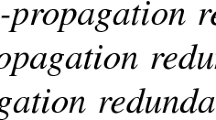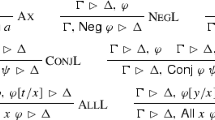Abstract
We introduce a relevancy detection algorithm to be used in conjunction with the SATCHMO prover. The version of SATCHMO considered here is essentially a bidirectional prover, utilizing Prolog (back chaining) on Horn clauses and forward chaining on non-Horn clauses. Our extension, SATCHMORE (SATCHMO with RElevancy), addresses the major weakness of SATCHMO: the uncontrolled use of forward chaining. By marking potentially relevant clause head literals, and then requiring that all the head literals be marked relevant (be “totally relevant”) before a clause is used for forward chaining, SATCHMORE is able to guide the use of these rules. Furthermore, the relevancy testing is performed without extending the proof search beyond what is done in SATCHMO. A simple implementation of the extended SATCHMO can be written in Prolog. We describe our relevancy testing approach, present the implementation, prove soundness and completeness, and provide examples that demonstrate the power of relevancy testing.
Similar content being viewed by others
References
Bancilhon, F., Maier, D., Sagiv, Y., and Ullman, J.: Magic sets and other strange ways to implement logic programs, inProc. 5th ACM Sympos. Principles of Database Systems, 1986, pp. 1–15.
Beeri, C. and Ramakrishnan, R.: On the power of magic, inProc. 6th ACM Sympos. Principles of Database Systems, 1987, pp. 269–283.
Bry, F.: Query evaluation in recursive databases: Bottom-up and top-down reconciled,Data and Knowledge Engineering 5 (1990), 289–312.
Chang, C. L. and Lee, K. C. T.:Symbolic Logic and Mechanical Theorem Proving, Academic Press, New York, 1973.
Demolombe, R.: An efficient strategy for non-Horn deductive databases,Theoretical Computer Science 78 (1991), 245–259.
Fujita, H. and Hasegawa, R.: A model generation theorem prover in KL1 using a ramified-stack algorithm, in K. Furukawa (ed.),Logic Programming: Proc. 8th Internat. Conf., MIT Press, 1991.
Fujita, M., Slaney, J. K., and Hasegawa, R.: New results in mathematics by a parallel theorem prover on a parallel inference machine, Technical Report ICOT-TR-1221, ICOT, Tokyo, 1992.
Hasegawa, R., Ohta, Y., and Inoue, K.: Non-Horn magic sets and their relation to relevancy testing. Technical Report ICOT-TR-834, ICOT, Tokyo, 1993.
Lloyd, J. W.:Foundations of Logic Programming, 2nd edn, Springer-Verlag, Heidelberg, 1987.
Lobo, J., Minker, J. and Rajasekar, A.:Foundations of Disjunctive Logic Programming, MIT Press, 1992.
Loveland, D. W.:Automated Theorem Proving: A Logical Basis, North-Holland, Amsterdam, 1978.
Manthey, R. and Bry, F.: SATCHMO: A theorem prover implemented in Prolog, inProc. of the Ninth Int'l Conf. on Automated Deduction, 1988.
Minker, J. and Rajasekar, A.: A fixpoint semantics for disjunctive logic programs,J. Logic Programming 9(1) (1990), 45–74.
Ramsay, A.: Generating relevant models,J. Automated Reasoning 7 (1991), 359–368.
Reed, D. W., Loveland, D. W., and Smith, B. T.: A near-Horn approach to disjunctive logic programming, inProc. 2nd Workshop on Extensions of Logic Programming (ELP'91), Lecture Notes in Artificial Intelligence 596, Springer-Verlag, Berlin, 1992, pp. 345–369.
Seki, H.: On the power of Alexander templates, inProc. 8th ACM Symposium on Principles of Database Systems, 1989.
Stickel, M. E.: Upside-down meta-interpretation of the model elimination theorem-proving procedure for deduction and abduction,J. Automated Reasoning (in press).
Stickel, M. E.: Schubert's steamroller problem: Formulations and solutions,J. Automated Reasoning 2 (1986), 89–101.
Wilson, D. S. and Loveland, D. W.: Incorporating relevancy testing in SATCHMO. Technical Report CS-1989-24, Duke University, 1989.
Author information
Authors and Affiliations
Additional information
This research was partially supported by NSF Grants IRI-8805696 and CCR-9116203. This paper is a major revision of Wilson and Loveland (1989).
Rights and permissions
About this article
Cite this article
Loveland, D.W., Reed, D.W. & Wilson, D.S. SATCHMORE: SATCHMO with RElevancy. J Autom Reasoning 14, 325–351 (1995). https://doi.org/10.1007/BF00881861
Received:
Issue Date:
DOI: https://doi.org/10.1007/BF00881861




